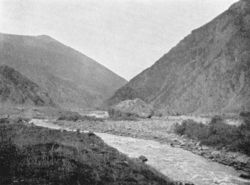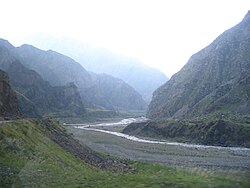Darial Gorge
| Darial Gorge | |
|---|---|
| Caucasian Gates | |
Terek |
The Darial Gorge


In history
The Darial originates from Dar-i Alān (در الان) meaning "Gate of the Alans" in
Josephus wrote that Alexander the Great built iron gates at an unspecified pass[5] which some Latin and Greek authors identified with Darial.[6]
Darial Pass fell into Sassanid hands in 252–253, when the
Importance
The Darial Pass was historically important as one of only two crossings of the Caucasus mountain range, the other being the Derbent Pass. As a result, Darial Gorge has been fortified since at least 150 BC.[1]
As the main border crossing between Georgia and Russia, it has been the site of Russians fleeing conscription for the
See also
Notes
- ^ Georgian: დარიალის ხეობა, romanized: darialis kheoba; Ingush: Даьра Аьле, Тийрк-чӀож, romanized: Dära Äle/Tiyrk-Chozh; Ossetian: Арвыком, romanized: Arvykom; Russian: Дарьяльское ущелье, romanized: Daryalskoe ushchelye.
- ^ "Garrison of the Iberians" (Greek: Iouroeipaach, Biraparach, from Armenian) https://iranicaonline.org/articles/darband-i-ancient-city
References
- ^ a b c One or more of the preceding sentences incorporates text from a publication now in the public domain: Chisholm, Hugh, ed. (1911). "Darial". Encyclopædia Britannica. Vol. 7 (11th ed.). Cambridge University Press. p. 832.
- ISBN 0-89577-087-3.
- ISBN 9781789251951.
- ^ a b Van Donzel & Schmidt 2010, pp. 51–52.
- ISBN 978-9004174160.
- ISBN 978-0415428996.
- ISBN 0-521-20092-X, 9780521200929, p. 141
- Patkanov). St. Petersburg, 1861, pp. 121
- ISBN 978-0-19-597713-4
- ISSN 0362-4331. Retrieved 2022-10-02.
- Bibliography
- Van Donzel, Emeri J.; Schmidt, Andrea Barbara (2010). Gog and Magog in Early Eastern Christian and Islamic Sources: Sallam's Quest for Alexander's Wall. Brill. ISBN 978-9004174160.
Further reading
- Banaji, Jairus (2019). "On the Identity of Shahrālānyōzān in the Greek and Middle Persian Papyri from Egypt". In Sijpesteijn, Petra; Schubert, Alexander T. (eds.). Documents and the History of the Early Islamic World. Brill. pp. 27–42.
- OCLC 495469456.
- Ognibene, Paolo (2022). "Beyond the Gate: Alans, Sasanians and the Caucasus". Sasanian Studies: Late Antique Iranian World. 1 (1): 207–214. .
- Sauer, Eberhard (2020). Dariali: The 'Caspian Gates' in the Caucasus from Antiquity to the Age of the Huns and the Middle Ages. Oxbow Books. pp. 1–1088. ISBN 978-1789251920.
